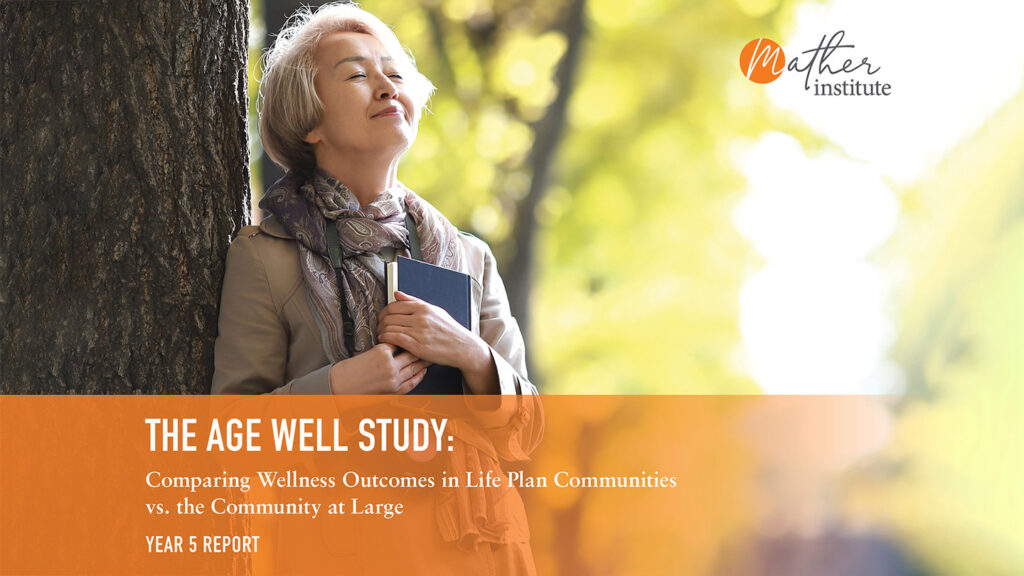
Five years ago, Mather Institute set out to better understand the health and wellness effects of residing in a life plan community. The organization found that residents reported higher levels of wellness compared with older adults living in the community at large.
Mather began the five-year longitudinal Age Well Study in 2018. The final year of the study examined changes in health and wellness among participants compared with Year 1.
Cate O’Brien, PhD, senior vice president of the Mather Institute, said that the Year 5 report revealed some “powerful findings” related to social engagement and, in particular, intellectual engagement, that were unexpected going into Year 1.
“By and large, the pandemic was really disruptive and had an adverse impact across different aspects of wellness,” O’Brien told McKnight’s Senior Living. ‘We expected to see, given what we saw in society, that residents would be affected in the same way. We didn’t exactly see that. We saw residents maintaining wellness in certain areas.”
Overall, the study found that residents continued to report better physical, emotional, social, intellectual and vocational wellness, but lower spiritual wellness, compared with community-dwelling older adults.
“We were cautiously excited regarding Year 1 results, where residents rated themselves higher on five of the six dimensions of wellness,” Mather President and CEO Mary Leary told McKnight’s Senior Living. “In Year 5, we realized this was no fluke, because they continued to rate themselves higher on the same dimensions.”
Year 5 reveals optimistic trends
The Age Well Study surveyed a total of 8,228 residents living in 122 life plan communities annually over five years. In Years 1 and 5 (2018 and 2022), resident responses were compared with responses from a demographically similar sample of older adults living in the community at large.
In Year 5, life plan community residents exhibited better self-reported health and higher levels of moderate physical activity compared with older adults from the community at large, according to Mather. As anticipated in this age group, participants from both groups showed a decrease in self-reported health.
Life plan community residents also maintained higher levels of life satisfaction, optimism and perceptions of aging, and lower levels of pessimism, compared with their community-at-large counterparts, according to responses. Changes over time, however, showed that emotional wellness tended to be more stable for older adults from the community at large, with life plan community residents reporting increased levels of depressive symptoms. Both groups also displayed declines in perceived control, as well as life satisfaction, over time.
In terms of social wellness, life plan community residents reported higher measures compared with their community-at-large counterparts. Loneliness increased for the residents, but social contact also increased.
Life plan community residents also reported better self-rated memory and higher participation in intellectual activities compared with their community-dwelling counterparts. Looking at changes over time, self-rated memory decreased among residents, whereas engagement in intellectual activities increased. Reading decreased for both groups.
Potential takeaways for operators
Senior living took a bad rap during the pandemic. Leary said that it is important for providers to broadcast the results of this study to showcase the benefits associated with living in life plan communities and how residents fared compared with those living in the community at large.
Senior living providers, she said, can use the results of the Age Well Study to improve their offerings for residents, including providing a variety of wellness options, encouraging and educating residents on healthy coping strategies, strengthening bonds among residents, offering wellness coaching to help residents identify opportunities for enhancing wellness, and encouraging residents to invite non-residents to on-site social events.
In the midst of this study, Mather introduced its Person-Centric Wellness Model, which includes three pillars of wellness: autonomy, affiliation and achievement. O’Brien said that the model was incorporated into the Age Well Study and revealed important relationships between those wellness-drivers and various other health and wellness outcomes.
Specifically, Leary said, Mather found that specific amenities or the quantity of amenities offered was not associated with greater life satisfaction, more positive perceptions of aging or higher perceived control relating to autonomy.
“This is giving us pause to think further about the optimum amenities to offer in future communities,” Mary said. “It might end up helping providers pivot and implement different amenities in the future.”
What’s next?
Due to timing differences in data collection, Mather is continuing to collect data on the community at large from the University of Michigan and will provide a final comparison of both life plan community residents and community-dwelling older adults next year.
The Mather Institute will host a live webinar May 18 and 24 to review the Year 5 findings from the Age Well Study.
As the study concludes, Mather already is beginning another longitudinal study related to Generation X. Two-thirds of depositors at The Mather in Tysons are baby boomers or, surprisingly, Gen Xers.


